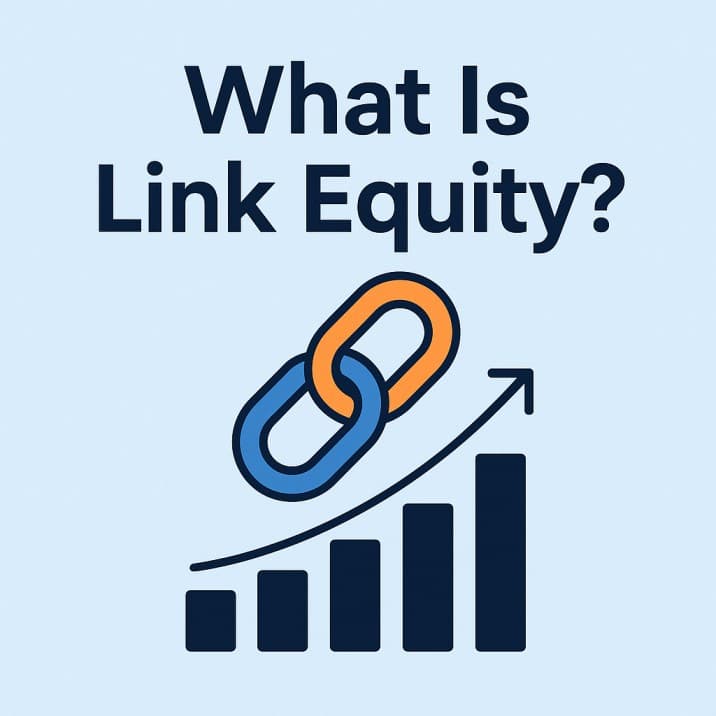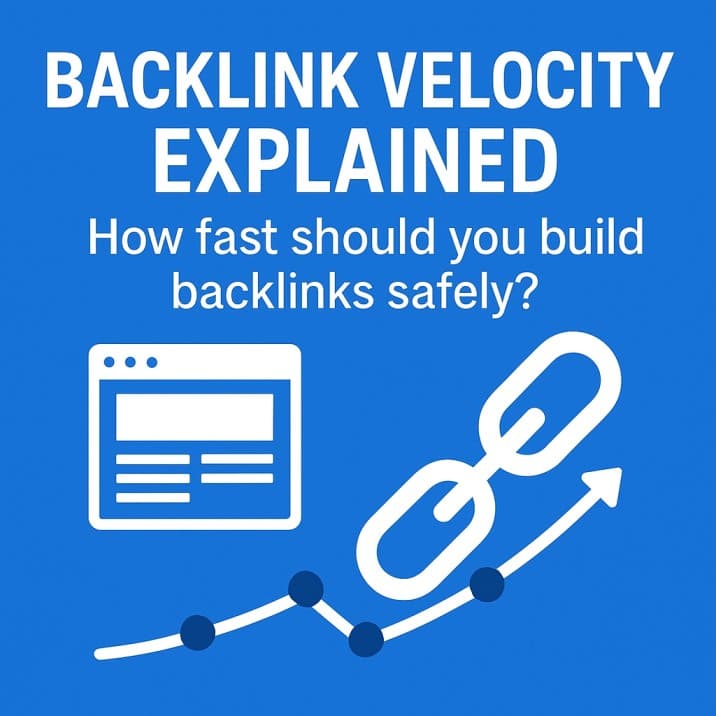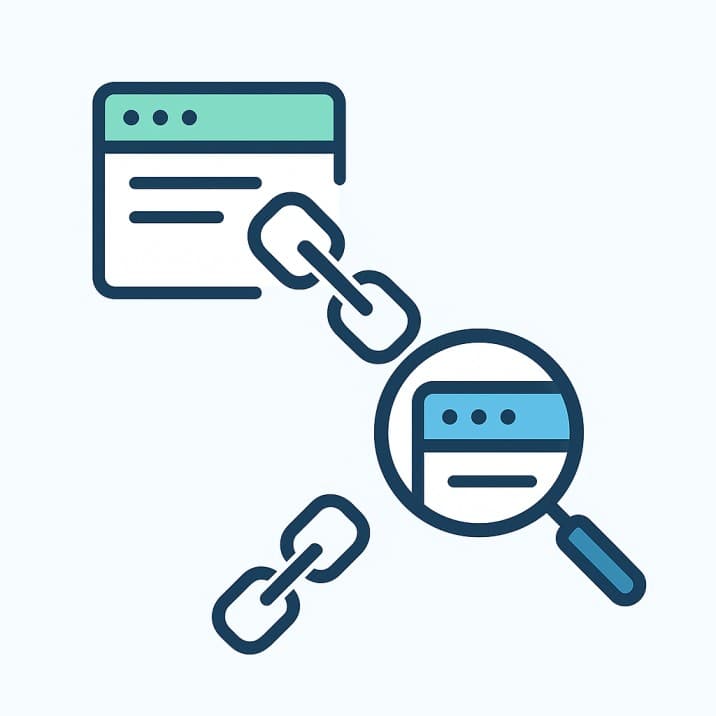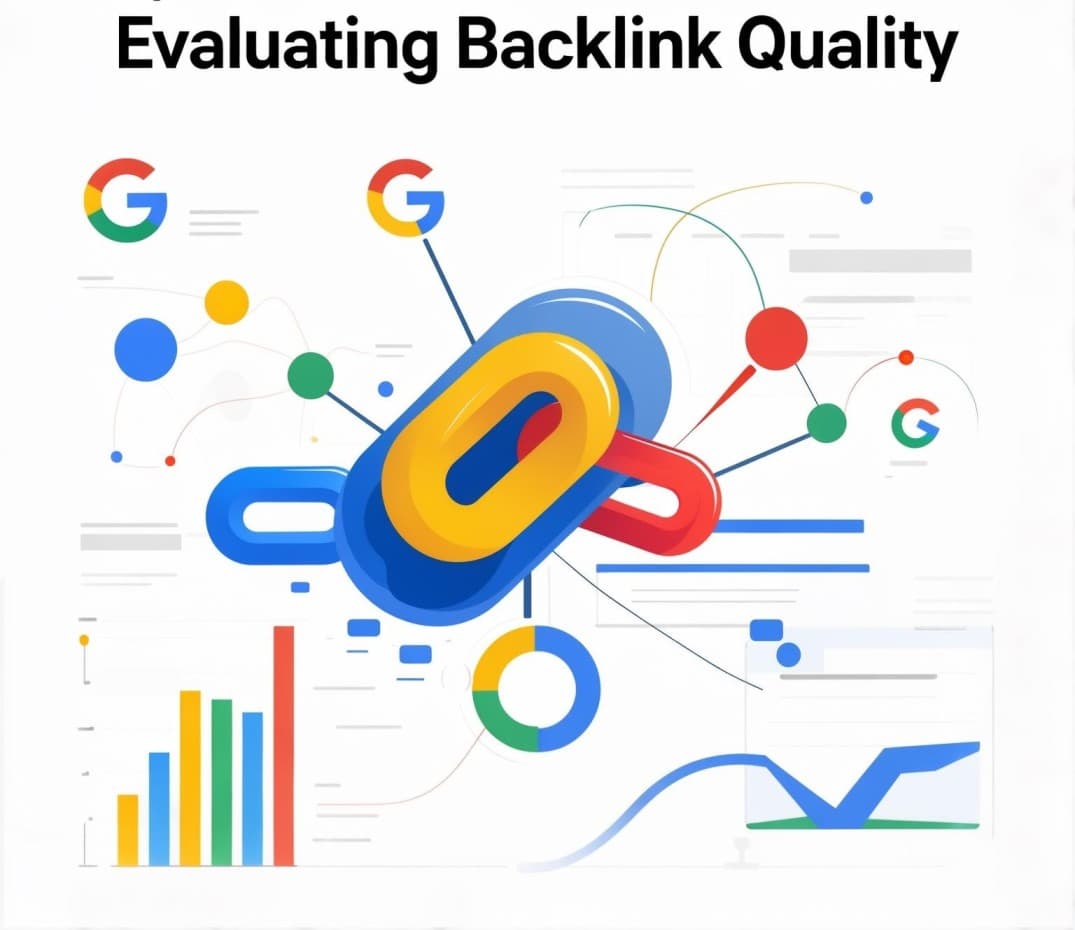
What Is Link Equity and How It Flows Through Your Website?
Every website owner wants better visibility in search results. Strong content and smart keywords are important. But there's one concept that many overlook link equity. It plays a key role in how your pages rank on Google.
Imagine your website as a group of connected pages. Some of those pages are stronger than others. The strength comes partly from the links they receive, either from other websites or within your own site. That strength is passed along through links, like energy flowing in a network. Search engines follow these paths to understand which pages matter most.
Many people call it link juice, but the right term is link equity. It reflects both the value and importance shared through links. It helps Google decide which page should show up higher in search results, even when two pages cover the same topic.
Knowing how link equity works is key for building a website that ranks better over time. It helps shape your internal links. It also guides you in choosing which pages to boost with external backlinks. Good use of link equity can lift up older or weaker pages on your site, without needing to build tons of new backlinks.
In this guide, you’ll learn:
- What link equity means
- How it flows through your website
- Why it matters for SEO
- And how to use it in a smart, ethical way
What Is Link Equity?
Link equity is the value that a link passes from one page to another. This value can influence how search engines rank web pages. When one page links to another, it shares some level of strength or importance. That strength is what we call link equity.
Search engines look at this link value when deciding how useful or trusted a page might be. If a strong page links to another page, that second page gains more trust in the eyes of search engines. This trust can lead to better rankings.
The term “link juice” is often used informally to describe the same idea. But the correct term, used by SEO professionals, is link equity. It's more than just passing power. It also includes the quality, relevance, and authority of the linking page.
One of the early foundations of this concept came from Google’s PageRank algorithm. PageRank was created to measure the value of a page based on how many other pages linked to it. Over time, Google has grown more advanced. Still, the base idea remains the same links help search engines judge a page’s value.
Not every link shares equal equity. Many factors affect how much value is passed, such as:
- The trustworthiness of the source page
- The relevance of the content between both pages
- Whether the link can be followed by search crawlers
In simplest way, you can think of link authority like a vote of confidence from one page to another. The better the source, the stronger the vote.
How Link Equity Works? (The Flow Mechanism Inside Your Website)
Link equity flows through your website by moving from one page to another through links. Each time one page links to another, it passes part of its value with it. This value helps the linked page earn more trust from search engines.
There are two types of links that pass equity:
- External links that come from other websites
- Internal links that connect pages within your own site
When a high-quality site links to one of your pages, that page gains equity. You can then use internal links to send some of that equity to other important pages on your site. This helps search engines discover and rank your content more efficiently.
For example, if your homepage has strong backlinks, internally linking it to a blog post or product page can help pass some of that equity. Search engines will see the connection and may treat that blog post or product page as more valuable.
The way anchor text is used also plays a role. When the anchor text is relevant to the page it links to, the equity flows more clearly. Search engines use this context to understand what the target page is about.
Not all links pass the same kind of value:
- Links marked as nofollow do not pass equity
- Equity is divided when a page has many links each one gets a smaller share
- The more trusted the linking page, the more value it can transfer
Key Factors That Affect Link Equity Value
Not every link gives the same value. Some links pass strong link equity, while others may pass very little or none at all. Search engines look at several factors before they decide how much trust or importance a link should pass.
Here are the most common factors that affect how link equity is shared:
1. The authority of the linking page
If a page has good backlinks from other trusted sites, it builds strong value. When that page links to another one, it can pass more link equity. A link from a well-known website will often carry more weight than a link from a low-traffic blog.
2. The relevance of the content
Link equity passes better when both pages are related in topic. For example, a page about digital marketing linking to an SEO guide makes more sense than linking to something unrelated like cooking. Search engines use content relevance as a strong signal.
3. The position of the link on the page
Links that appear inside the main body of a page tend to carry more value than those in the footer or sidebar. Context also matters. Links placed in meaningful sentences can provide stronger signals to search engines.
4. The type of link used
Only certain types of links can pass link equity. For example:
- Followed links pass value
- Nofollow, sponsored, and UGC links do not
Search engines may still crawl them, but they usually won’t pass authority.
5. Number of links on the page
When one page links to many other pages, the link equity is split between them. If there are too many links, each one receives a smaller share. This is known as link dilution. Fewer, more focused links usually pass more value.
6. Anchor text
The clickable text in a link helps search engines understand what the linked page is about. If the text is relevant to the topic, and used in a natural way, it improves the flow of link equity.
The Role of Internal Linking in Link Equity Distribution
Internal links connect one page on your website to another. These links help search engines understand the structure of your site. More importantly, they help spread link equity from stronger pages to other important pages that you want to rank higher.
When a page on your site gets backlinks from other websites, it earns outside trust. That trust, or link equity, stays mostly within that page unless it’s shared with others. Internal links allow you to pass that value to other parts of your website.
For example, if your homepage has the most authority, you can add links from your homepage to deeper pages like product pages or helpful blog posts. This direct connection makes it easier for search engines to evaluate those pages. It also helps users find related content more easily.
Search engines follow each internal link to explore more pages. If a page does not have any links pointing to it, that page becomes harder to find. These isolated pages are often called orphan pages. They miss out on both link equity and organic visibility.
The structure of your internal links also affects how equity flows. A clear linking plan helps equity flow with less effort from search engines. This creates a better network within your site. It also improves how well each page performs in search results.
Using anchor text with keywords is helpful, but make sure the words match the content of the page being linked. The link should guide both the user and the search engine toward something useful and related.
Organizing your website into topic clusters or content hubs also supports better equity flow. These structures help group related content together. A central page links out to related pieces and each topic supports the next. This keeps value moving within a well-organized system.
How to Optimize Your Link Equity Flow?
Improving how link equity moves through your website can help you get better rankings without needing more backlinks from other sites. You can achieve this by making a few focused changes to your site’s internal structure.
Here are simple strategies that help boost your link equity flow:
1. Run an Internal Link Audit
Start by checking which pages on your website have the most backlinks. These pages carry authority. Make sure they link to other valuable pages across your site. Use SEO tools like Google Search Console or Screaming Frog to scan your internal link map. Look for pages that have very few or no internal links pointing to them.
2. Fix Broken or Redirected Links
Broken links stop equity from reaching other pages. Fix them so the equity flows without interruption. If you need to redirect a page, use a permanent redirect (301), not a temporary one. A 301 redirect helps pass most of the original authority to the new page.
3. Balance Your Link Structure
Avoid placing hundreds of links on one page. When a page links out too often, each link passes only a small amount of equity. Instead, choose links wisely. Focus on linking to pages that support your goals or offer helpful information. This reduces link dilution and keeps the equity strong.
4. Use Internal Links from High-Traffic Pages
Pages with strong search performance often have higher link value. Use internal links from these strong pages to promote other pages that need more visibility. This flow reaches your newer or weaker content and helps it gain more trust from search engines.
5. Improve Anchor Text Placement
Anchor text tells search engines what the linked page is about. Keep it short, relevant, and natural. For example, link to a guide using its title or target topic. Avoid using vague words like “click here” or “read more” as anchor text. These pass less context and can weaken the link’s value.
6. Update Older Content to Support Newer Pages
Older blog posts and key pages already have authority. You can add internal links from these older pieces to newer ones. This gives your recent content a better chance to get indexed and ranked more quickly.
7. Organize Pages Using Topic Clusters
Create a main page for a topic, and connect it to related sub-pages. This setup helps equity flow from one central source to supporting content and back. Topic clusters also improve how Google understands the themes within your website.
Common Mistakes That Waste Link Equity (And How to Avoid Them)
Even with a strong SEO plan, small issues on your website can block or weaken the flow of link equity. These mistakes may seem minor, but over time, they can affect how well your pages rank in search results.
Here are some common errors and how to fix them:
1. Using Too Many Nofollow Tags on Internal Links
Some sites use nofollow on links inside their own pages to try to control crawl behavior or rankings. But this cuts off the flow of equity within the site. Unless there’s a clear reason like user-generated content, internal links should be followable so they pass value.
Fix: Check your site for internal links marked as nofollow and replace them with normal, followed links.
2. Ignoring Internal Linking in Blog Posts
Many blog pages are left without internal links pointing to key service or product pages. When this happens, the value from blog content does not support your revenue-focused pages. This also weakens site structure.
Fix: Add relevant internal links in your blog posts that guide readers to other important areas of your site. Use meaningful anchor text related to the linked topic.
3. Linking to Low-Quality or Unrelated External Sites
Outbound links to poor content or untrusted domains don’t just lower user experience, they may also waste some of your page’s authority. While not always harmful, too many links to weak or unrelated pages can raise red flags.
Fix: Review your external links. Link only to trusted, helpful sources that support your content.
4. Leaving Orphan Pages Unlinked
An orphan page has no internal links pointing to it. This makes it hard for both users and search engines to find and value the page. These pages often stay hidden from search results.
Fix: Identify orphan pages using tools like Google Search Console or a site crawler. Add links to them from other relevant pages.
5. Using Deep Click Paths
If a page takes four or more clicks to reach from the homepage, search engines may treat it as less important. Deep pages often receive little or no link equity, even if they hold strong information.
Fix: Improve your site’s structure to reduce click depth. Link to key pages from your homepage or main categories.
6. Overloading Pages with Too Many Links
Pages that link to dozens or hundreds of other pages can cause link dilution, each link passes very little value. This hurts the strength of your most important links.
Fix: Focus your links. Keep only what supports the content and the user’s journey. Remove unhelpful or repeated links.
Tools You Can Use to Analyze Link Equity
Understanding how link equity flows across your website starts with the right tools. These tools help you find strong pages, weak links, and areas where value is being lost. With this insight, you can improve your internal linking and strengthen your overall SEO performance.
Here are some reliable tools that help you look deeper into your link structure:
1. Google Search Console
Google’s free tool offers a Link report that shows which pages receive the most links on your site. You can see both internal links and external links pointing to your pages. Use this report to identify which pages have built authority and which ones need better internal link support.
- Navigate to: “Links” > “Internal Links”
- Look for key pages with low internal link counts
- Add links from stronger pages to these underperforming ones
2. Screaming Frog SEO Spider
This desktop tool crawls your site like a search engine. It maps your entire internal link structure and shows how link equity flows across your pages. You can sort pages by how many internal links point to them. It also shows issues like broken links, redirect chains, and orphan pages.
- Use the “Internal” tab to view link counts
- Spot pages with no incoming internal links
- Export crawl reports to organize improvements
3. Ahrefs
Ahrefs provides a full picture of both backlinks and internal linking. Its Site Audit tool detects internal linking issues like low-link pages and redirect loops. The “Best by Links” report shows which pages carry the most equity, so you can pass it to newer content by linking smartly.
- Use “Internal Backlinks” feature in Site Explorer
- Review the “Best by Links” to find top authority pages
- Add internal links from high-value pages to target pages
4. SEMrush
Like Ahrefs, SEMrush includes a Site Audit feature that highlights internal linking errors, orphaned pages, and crawl depth issues. It allows you to spot weak link paths across your website.
- Use the Internal Linking Overview
- Monitor internal link scores
- Track changes as you improve your structure
5. Sitebulb
Sitebulb combines technical crawling with visual reporting. It shows how link equity is affected by crawl depth, broken links, and page importance. It’s useful if you prefer data displayed in charts and graphs rather than raw tables.
- View internal linking graphs
- Identify deep pages that receive little attention
- Use visual flow paths to plan better linking strategies
Future of Link Equity: What Google May Be Moving Toward?
Search engines continue to evolve, and so does the role of link equity in SEO. While links are still a strong ranking signal today, Google has made it clear that it now looks at more than just links to understand authority and relevance.
Over time, we may see changes in how link equity is measured and shared. Here are a few trends that may shape the future:
1. Less Focus on Raw Backlink Count
In the past, the number of backlinks mattered more. Now, link quality and relevance carry more weight than quantity. Google may continue shifting toward signals that show real trust and context, rather than just the presence of links.
2. Better Understanding of Content Context
Google’s systems are now better at understanding topical relevance. Instead of just looking at anchor text, Google looks at the full content around the link. This creates a more accurate view of whether a link adds value or not.
Because of this, equity may pass more strongly when the content around the link matches the topic of the page being linked to.
3. Less Dependence on PageRank
While PageRank still exists behind the scenes, it’s no longer visible to the public, and it may be used less directly in ranking. Today, signals like content quality, user interaction, and site experience play a bigger role in how pages perform.
Even with this change, internal linking will remain important because it supports both crawlability and usability, which Google values highly.
4. Focus on User Trust and Website Experience
As part of Google’s EEAT (Experience, Expertise, Authoritativeness, Trustworthiness) model, trust signals from a website matter more than before. Internal linking, when done well, increases user experience. It helps connect ideas, makes navigation smoother, and builds a more trustworthy site.
Smart use of link equity supports this model, especially when your links improve reader understanding, rather than just attempt to boost rankings.
5. AI and Semantic Relevance
Search engines now rely on machine learning to understand topics without needing exact keywords. Link equity in the future may pass more naturally between pages that are semantically related, even if the keywords don’t perfectly match.
Keeping your content tied together around clear topics, including strong internal linking between related ideas, will keep your site relevant as search engines move further into AI-powered understanding.
Final Thoughts: Wrapping It All Up
Link equity plays a quiet but powerful role in how your website grows in search results. Whether it comes from other sites or flows through your own pages, it acts as a signal of value and trust.
Using internal links with purpose helps you guide that value where it matters most. Strong pages pass equity to weaker ones. New content finds a path to be discovered. Orphan pages get connected, and site structure becomes easier for both users and search engines to follow.
Instead of chasing more backlinks alone, focus on building a site that keeps equity inside. Your homepage, pillar content, and high-performing pages should all support other areas of your site through direct and clear links.
Avoid common problems like broken links, deep pages, or random anchor text. And use tools that help you track where your equity is going and where it’s being lost.
More than anything else, think of internal linking as a way to organize your website for people first. If your links make sense to your visitors, they’ll make sense to search engines too.
A well-linked site is a strong site. And a strong site leads to steady, long-term growth.
Frequently Asked Questions
What is link equity in SEO?
Link equity is the value or authority passed from one page to another through a link. Pages that receive strong external or internal links can rank higher in search results. This value helps search engines decide which pages hold more trust.
How does link equity flow through a website?
Link equity flows through both internal links and links from other websites. When one page links to another, it shares part of its strength. That strength helps the linked page gain more visibility in search engines. A clear internal linking plan supports better equity flow.
What’s the difference between link equity and link juice?
Both terms describe the same idea, but link equity is the more accurate and professional term. Link juice is an older, informal phrase. They both refer to the value passed through links.
Do nofollow links pass link equity?
Nofollow links are links marked to tell search engines not to pass authority or trust. These links usually do not carry link equity. They may still have value for traffic or visibility but affect rankings much less.
Can internal links pass the same value as backlinks?
Internal links can help pass link equity between your own pages, but backlinks from trusted external sites often carry stronger value. However, smart internal linking helps distribute that value across your entire website.
What is link dilution?
Link dilution happens when a page has too many outgoing links. The available link equity is split between them, lowering the amount each one receives. Keeping your links focused helps preserve value across key pages.
What tools can I use to check link equity?
You can use tools like Google Search Console, Ahrefs, SEMrush, or Screaming Frog to view link flows, broken links, orphan pages, and other issues that may affect your site’s link equity distribution. These tools help you manage and improve your internal linking structure.
Do anchor texts affect link equity?
Yes. Anchor text helps search engines understand the topic of the linked page. Relevant, clear anchor text improves the quality of the link and helps equity pass more effectively.








